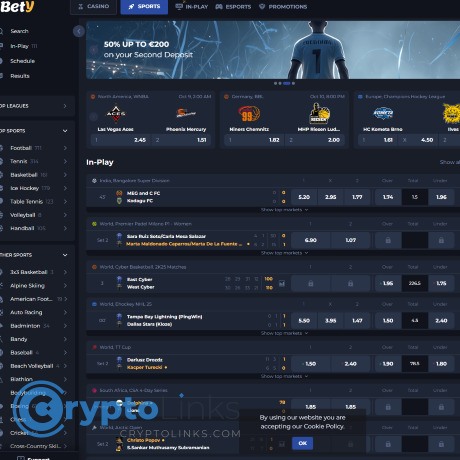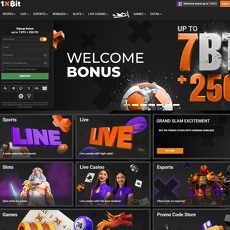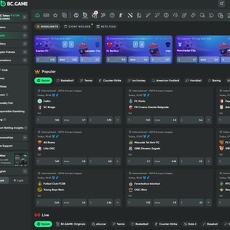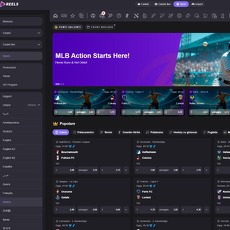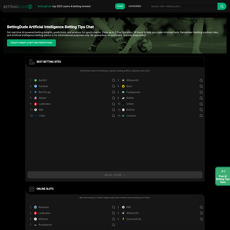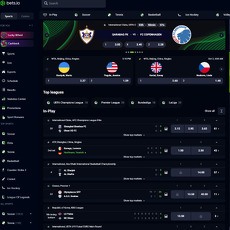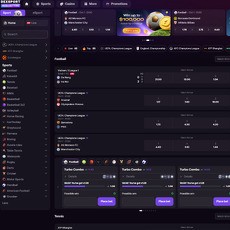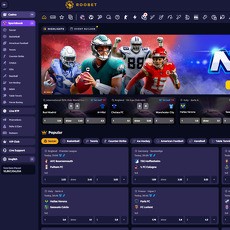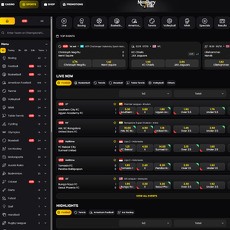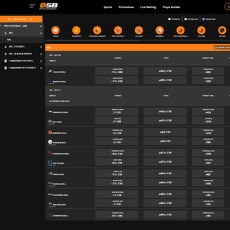Bety.com Review
Bety.com
bety.com
Bety.com Sportsbook Review: The Ultimate Guide to Odds, Free Bets, and Payouts (with FAQ)
Heard the buzz about bety.com and wondering if it’s legit, how the odds work, and whether the bonuses are actually worth your time?
You’re in the right place. I’ve tested dozens of crypto-friendly books over the years, and I know exactly where bettors get tripped up—confusing odds, slow payouts, bonus fine print, and messy bet slips. This guide keeps it clean and practical so you can bet smarter and stay in control.
By the time you’re done, you’ll know whether bety.com fits your style, how to read odds like +120 in seconds, and how to use free bets without donating value back to the house through terms you didn’t notice.
The problems most bettors face when checking a new sportsbook
New sportsbooks can feel like a maze. Here are the common sticking points I see all the time:
- “Is it legit?” You want clear license details, real company info, responsible gambling tools, and a payout track record—not just a glossy homepage.
- Odds confusion. American odds like +120 and -160 look simple but lead to mistakes. Example: +120 means a $100 stake returns $120 profit if it hits; -160 means you’d risk $160 to win $100. Tiny misunderstandings here cost real money.
- Reading the bet slip. Missing a toggle, misclicking a parlay, or locking odds after a line move can change your payout drastically.
- Free bet traps. Most free bets use stake not returned mechanics. If you win a +200 bet with a $50 free bet, you typically get $100 profit—not the $150 you’d expect with your own cash. Expiries and minimum odds can also reduce value if you’re not careful.
- Payout speed and limits. Crypto helps, but you still need to know minimums, confirmations, and the common reasons withdrawals get delayed (wagering not met, mismatched details, network fees).
- Live betting whiplash. Lines shift fast. If you don’t understand why the price moves or which markets get suspended, you’ll constantly chase bad numbers.
Quick reality check: Research on sports betting markets shows consistent behavioral pitfalls—like chasing “longshots” at poor prices (see the well-known “favorite–longshot bias”). Get the basics right and you’re already ahead of the pack.
Promise solution
Here’s how I’ll keep this simple and useful:
- Trust signals, at a glance: What to check on bety.com before you deposit a satoshi.
- Odds you can read in seconds: How to interpret +120, -160, and the quick math behind them so you don’t overpay for bets.
- Free bets without the fine-print headache: The exact steps and rules to look for so promos actually work for you.
- Banking clarity: Coins, fees, minimums, and a test-withdrawal strategy that saves stress.
- Live betting sanity: Why lines move, how to time wagers, and ways to avoid betting into bad prices.
No fluff, no empty hype—just the details you need to make good decisions and protect your bankroll.
What you’ll learn in this guide
- A quick snapshot of bety.com so you know what you’re walking into.
- An “Is it legit?” checklist you can run through in minutes.
- How to sign up, deposit, and withdraw with notes on fees, limits, and speed.
- How to read +120 and other odds quickly, including when to prefer underdogs or favorites.
- How to read a bet slip/ticket so you never miss a toggle or lock the wrong price.
- How to use free bets the right way and avoid terms that drain value.
- Pros, cons, and who bety.com is best for based on real sportsbook needs.
Ready to see who bety.com is actually built for and what you’ll find inside? The next section breaks it down in plain English—no guesswork, no jargon. Want the fast snapshot and the crypto details first?
bety.com at a glance: who it’s for and what’s inside
What bety.com is and the core features
bety.com is a crypto-friendly sportsbook that focuses on quick funding and mainstream action with a strong emphasis on live betting. If you like to jump into games as they’re unfolding, this layout makes sense: the event carousel is usually front-and-center, odds refresh quickly, and common bet types are one tap away.
Expect the usual playbook of markets and betting styles you already know:
- Moneyline, spread, totals: The staples for NFL, NBA, soccer, MMA, tennis, and more. Example: NFL spread -3.5 (-110), Premier League over 2.5 (+115).
- Props and player markets: Things like “Player Points Over/Under,” “Shots on Target,” or “First Goal Scorer.” Example: NBA Player Points Over 24.5 at -105.
- Parlays and same-game combos: Stack multiple legs for a bigger payout. Example: Team to Win + Star Player Over 1.5 3-pointers + Total Over 219.5.
- In-play betting: Odds react to every possession, corner, or break point—think “Next Team to Score,” “Race to 5 points,” or “Result After 10 Minutes.”
One practical point: availability can vary by region. If you see “restricted” banners or blocked markets, that’s geo-filtering at work. Don’t try to bypass it—aside from the compliance risk, it can lead to withdrawals being held later if verification is requested.
“Bet the moment, not the hype.” In live betting, the best price usually appears when everyone else hesitates.
Crypto-friendliness and supported currencies
The biggest win here is speed. Crypto deposits are typically credited after network confirmations, which means you can place bets faster than old-school bank routes. You’ll commonly see support for:
- BTC (Bitcoin) — widely accepted, slower confirmations during peak times.
- ETH (Ethereum) — fast when the network is calm; fees can spike with congestion.
- Stablecoins like USDT and USDC — often offered on multiple networks (ERC20, TRC20); TRON routes tend to be cheaper.
- LTC or DOGE — sometimes available for lower-fee transfers.
Availability can change and sometimes depends on your country. Always confirm the exact coin and network inside the cashier before sending. Sending USDT on the wrong chain is a classic mistake that can’t be undone.
If you’re new to crypto, here’s the simple playbook:
- Wallet setup: Use a reputable wallet (hardware or trusted software). Back up your seed phrase offline—no screenshots, no cloud storage.
- Choose the right network: Match the deposit address format and network shown in the cashier. If it says USDT-TRC20, do not send ERC20.
- Confirmations: Many books credit after 1–3 confirmations for BTC and a handful for ETH and stablecoins; the exact number depends on the site’s policy.
- Fees: Expect cents on TRON, low fees on LTC, and potentially higher fees on ETH during busy periods. Time your transfer when gas is cheaper if you can wait.
- On-ramps: Some sportsbooks integrate third-party fiat on-ramps (e.g., MoonPay, Ramp, Transak). These services add KYC and their own fees—check the quote before you buy.
Pro tip: send a tiny “test” transaction first. If it lands correctly and the credit hits your sportsbook balance, then send the main amount. This one step has saved more people than I can count.
Who will like bety.com (and who won’t)
bety.com shines for bettors who want crypto-first convenience and live markets that don’t feel like a chore to navigate. If you enjoy tracking momentum, reacting to injuries or red cards in real time, and you want funds in and out without waiting on a bank holiday, this setup feels right at home.
- You’ll probably like it if:
- You fund with BTC, ETH, or stablecoins and care about quick credits.
- You bet mainstream leagues and popular props, with occasional parlays.
- You enjoy in-play markets and need odds that refresh fast without clunky reloads.
- You might not love it if:
- You need phone support—most crypto-first books lean on live chat and email.
- You only use cards and bank wires with no interest in crypto.
- You want ultra-niche markets that smaller or region-specific books specialize in.
One last thing before you press deposit: a platform can look slick and still be a headache if its compliance and payouts aren’t buttoned up. Curious how to tell the difference quickly—without sifting through marketing pages?
Is bety.com legit? Security, licensing, and trust factors
Let’s get straight to it: when I check if a sportsbook is safe, I’m not swayed by glossy banners. I’m looking for hard proof that my funds and bets are protected, and that I’ll actually get paid. As I always say,
“Trust is earned at the withdrawal screen, not on the homepage.”
Here’s exactly how I assess whether bety.com is legit, what security signals matter, and the reputation clues you should verify before you send a single satoshi.
Licensing and ownership checks
Licensing is step one. Not because regulators make every site perfect, but because a valid, verifiable license gives you a real escalation path if something goes wrong.
My 10-minute license checklist for bety.com:
- Footer scan: Look for a license number and regulator logo in the site footer. Common formats you’ll see across crypto books:
- Curaçao: 8048/JAZ, 365/JAZ, with a validator link (often provided by Antillephone or Gaming Curaçao).
- Malta (MGA): MGA/B2C/XXXX/20YY with a checkable entry on the MGA register.
- Anjouan/Kahnawake/Isle of Man: a license number plus a regulator link you can confirm on the official site.
If bety.com lists a license, click the seal. You should land on a regulator page naming bety.com (or its exact corporate entity) with a live status.
- Terms and Conditions page: Note the legal entity’s name, registration number, and address. Paste that name into the relevant corporate registry or a web search to see if it’s real and active.
- Regulator cross-check: Use the official register to confirm the domain/entity:
- MGA Licensee Register
- Antillephone Validator (Curaçao)
- Gaming Curaçao Validator
- Domain age and consistency: A quick WHOIS (e.g., whois) check reveals the registration date. New domains aren’t a deal-breaker, but a mature domain plus a consistent corporate trail is a stronger signal.
- Transparency tells: Clear house rules, named data providers (e.g., Opta for soccer stats), and public audit statements are all green flags.
If any of these links are missing or broken, ask support for the validator URL. No verifiable license info at all? That’s a serious red flag.
Site security and fair play
Licensing tells you who’s watching. Security tells you how they protect you. I want to see both.
Security signals I check on bety.com (and any book):
- HTTPS/TLS quality: The padlock isn’t enough. Run the domain through SSL Labs. I aim for an A rating, TLS 1.2+ (ideally 1.3), and HSTS enabled.
- Two-Factor Authentication (2FA): TOTP (Google Authenticator/Authy) is a must. Email-only 2FA isn’t strong. Google’s research shows multi-factor stops the vast majority of account-takeover attempts; turn it on immediately.
- Withdrawal protections: Address whitelisting, a 24-hour withdrawal lock after password changes, and email confirmations for each payout. These features block most opportunistic theft.
- Wallet handling: It’s a plus if the site states that the majority of user funds are held in cold wallets and withdrawals are batched on-chain. If they mention internal risk checks, even better; it means they’re thinking about security, not just speed.
- Session and device controls: View active sessions, sign out remotely, and get alerts for new device logins. If you can’t see these, ask support how they handle device security.
Fair play and rules clarity (where many bettors get burned):
- Settlement policy visibility: There should be a clear “House Rules” page covering cancellations, voids, pushes, and stat sources.
- Concrete examples I look for:
- Tennis retirements: Some books settle moneylines after the first set; others require full match completion. If you’re betting tennis on bety.com, check this rule first.
- Soccer abandoned matches: Will they settle after 24 hours if resumed, or void if not completed in the scheduled window?
- Player props data: Do they cite official providers (e.g., Opta, Sportradar)? If a bet is graded on “unofficial” stats, disputes become painful.
- Dead-heat rules (for ties in props/futures): Are payouts proportionally reduced? The rule should be explicit.
- Odds transparency: Time-stamped odds on the bet slip and a clear record in your bet history. If a price changes at placement, the slip should prompt you to accept or reject.
- Responsible gambling tools: Deposit limits, time-outs, and self-exclusion should be available without arguing with support.
One more practical tip: take screenshots of your slip and the related rule section before big bets, especially for niche markets. If a dispute arises, that record helps.
Reputation snapshot and third-party references
No brand gets a free pass. I look for consistent payout behavior and how they respond when things go wrong.
Where I check bety.com’s reputation:
- Community signals: Search “bety.com withdrawal”, “bety.com KYC”, and “bety.com limits” on Reddit (r/sportsbook, r/cryptocurrency), Trustpilot, and specialized forums. One-off complaints happen; patterns matter.
- Support responsiveness: I’ll ask support two or three specific questions (license validator link, tennis retirement rule, withdrawal timings). Speed and accuracy of replies tell you a lot.
- Small real-money test: Deposit a small amount, make one low-hold bet, and request a small withdrawal. Track the timeline and the exact KYC they ask for.
For added context, according to a review on Bitcoin.com, bety.com is considered a reliable, legal option for secure betting. That’s encouraging, but it’s not a substitute for your own verification. Always confirm the license link and run a small withdrawal test yourself.
Why this caution pays off: Year after year, the Verizon Data Breach Investigations Report highlights compromised credentials as a leading cause of account incidents. Turn on 2FA, use a password manager, and whitelist your payout address. These simple steps shut the door on most attacks before they start.
So, what happens next when you’re ready to try it—what info will you need, when does KYC kick in, and how do you avoid the classic withdrawal delays? I’m going to show you the fastest path from signup to your first successful cash-out in the next section. Ready to set up the account the smart way?
Getting started: account, KYC, deposits, and withdrawals
Signup and verification
Getting a fresh account up on bety.com is quick, but the smoothest journeys are the ones you prep for. Here’s how I handle it so I don’t get stuck later when it’s time to cash out.
- Create your account: Use a unique email, a strong password, and enable 2FA right away. I use an authenticator app (not SMS) and save backup codes offline.
- KYC: do it early if you plan to withdraw soon. Crypto sportsbooks often run risk-based checks. Triggers include larger withdrawals, bonuses, multi-account flags, or geo issues. Have the basics ready:
- Photo ID (passport or driver’s license),
- Selfie (liveness check),
- Proof of address (utility bill/bank statement, under 3 months).
- Time expectations: Light checks can clear in minutes; full reviews can take a few hours to 24–48 hours. Weekends and high-traffic events can slow queues.
- Respect regional rules: If your country is restricted, don’t try to bypass with a VPN. That’s the fastest route to a locked account.
“Measure twice, send once.” A 60-second check now can save a 60-hour headache when you want your winnings.
Why 2FA matters: Google’s security research shows basic two-step verification blocks the vast majority of account hijacking attempts, especially automated bots and bulk phishing. It’s the single easiest insurance policy you can enable today. Source: Google Security Blog.
Deposits: methods, fees, and minimums
bety.com is crypto-friendly, so you’ll typically see popular options (think BTC, ETH, and major stablecoins like USDT/USDC across common networks). Always confirm the exact list, minimums, and networks in the cashier before sending anything.
- Network selection matters: Pick the same network in your wallet and at the cashier. For example, USDT on TRON (TRC20) vs. USDT on Ethereum (ERC20) are not interchangeable.
- Typical credit times:
- BTC: often credited after 1–3 confirmations (about 10–30+ minutes depending on fees and congestion).
- ETH/ERC20: usually a few minutes when gas is normal; sportsbooks may wait for multiple block confirmations.
- TRC20 (USDT): often fast and cheap; I’ve seen credits in 1–3 minutes when the network is clear.
- Fees: The blockchain fee is on you. Check live estimators before sending:
- BTC fee estimator
- ETH gas tracker
- TRON status
- Minimums: Many books set minimums around the crypto equivalent of $10–$20. If you’re close to the minimum, add a small buffer so network fees don’t leave you short.
Example (purely illustrative): If the cashier shows a 10 USDT minimum on TRC20, I’ll send 12–15 USDT to cover any tiny fee and avoid miscredit. I always paste the address, verify the first and last 4 characters, and scan the QR to reduce typo risk.
Withdrawals: speed, limits, and common pitfalls
Cash-out is where most complaints across the industry happen. Not because books don’t pay, but because details get missed. I set myself up for success like this:
- Use the same coin and network you deposited with. Many sportsbooks insist on “return to source.” Mixing ERC20 and TRC20 versions of the same token causes delays or rejected requests.
- Expect a review window: Internal processing can run 15 minutes to a few hours. First-time withdrawals and bonus-related cash-outs often take longer.
- Know your limits: There may be daily/weekly caps per coin. If you hit them, split requests across days.
- Clear wagering before requesting:
- Standard deposits: Many books require at least 1x turnover (bet your deposit once) to reduce AML flags.
- Bonuses/free bets: Rollover rules apply. If you haven’t met them, expect a hold, partial release, or bonus removal.
- Watch for memo/tag requirements: If you withdraw to assets like XRP or certain exchange wallets that need a memo/tag (or destination tag), triple-check it. If you’re not 100% sure, withdraw to a personal wallet first, then move to the exchange.
- Names must match: If KYC is requested, the account name and payout destination must align. Mismatches are a classic delay trigger.
Example timeline (illustrative): I request a 30 USDT TRC20 withdrawal. It’s approved in 45 minutes, broadcast shortly after, and lands in my wallet within a few minutes. If I had an active bonus with unmet rollover, that same request would likely wait until I finished the wagering or chose to forfeit the bonus according to the T&Cs.
Note: Regulators worldwide push for stronger ID checks, especially at withdrawal—another reason to verify early. The UKGC and similar bodies have emphasized identity and affordability checks to reduce disputes and speed up withdrawals; getting your documents ready is the best counter to delays. See UKGC guidance on verification: gamblingcommission.gov.uk.
Banking best practices
- Run a small test withdrawal first: After your first win, request a small cash-out. It confirms your details, speed, and any KYC asks—before you’re sitting on a bigger balance.
- Whitelist addresses and lock them with 2FA: Many wallets and exchanges let you whitelist payout addresses. Turn it on, and require 2FA to add/change them.
- Keep a quick ledger: Note deposit amounts, transaction IDs, networks, timestamps, and bonuses used. If support asks, you’ll respond in seconds.
- Choose efficient networks for frequent banking: Stablecoins on low-fee networks (e.g., TRC20) keep costs predictable for active bettors. If you prefer BTC, use adequate fees during peak times to avoid hour-long waits.
- Don’t mix coins or networks midstream: Start with one coin, stick with it until you’ve completed your cycle (deposit → betting → withdrawal). Switch later if you want.
- Confirm everything before you send: Address checksum, network type, minimums, and fee settings. A wrong chain is often unrecoverable.
- Avoid bonus tangles if you need speed: If you plan to withdraw quickly, skip bonuses until you’re familiar with the rollover.
Ready to fund your account is one thing—knowing where to put that first bet is where the real edge begins. Want to see how I spot value and what +120 actually means before you lock in your slip?
Markets, odds, and live betting: how to spot value
Sports coverage and bet types
When I open a new sportsbook window, I’m looking for two things: breadth and depth. For a crypto-friendly book like bety.com, expect mainstream coverage and enough variety to keep value hunters busy. Typical areas you’ll see:
- Major leagues: NFL, NBA, MLB, NHL, soccer (EPL, UCL, La Liga), UFC, tennis, golf, F1, and eSports.
- Pregame staples: moneylines, spreads, totals, and team/player props.
- Live betting: real-time spreads/totals, period bets, player props that update as the game changes.
- Futures: title winners, season awards, win totals.
- Parlays and Same-Game Parlays (SGP): combine markets for a shot at bigger payouts—just remember, more legs = more hold for the book.
I hunt for markets where the book may be slower to adjust—live player props, niche tennis sets, and late-night hoops totals often hide pockets of value.
Understanding odds: what does +120 mean?
Odds are just pricing. Learn to read the price, and you’ll stop guessing.
- +120 means underdog odds. A $100 stake returns $120 profit if it wins (total return $220).
- -160 means favorite odds. You risk $160 to win $100 (total return $260).
- Decimal quick view: +120 = 2.20; -160 = 1.625.
- Implied probability: +120 ≈ 45.45% (100 / 220). -160 ≈ 61.54% (160 / 260).
Here’s the trick: compare the implied probability to your estimate. If you believe a +120 shot actually hits 50% of the time, you have an edge.
Example: You price an underdog at 50% but the book offers +120 (45.45%). That’s a positive expected value (EV) bet. Using a fractional Kelly approach for bankroll discipline: with +120 (b = 1.2), p = 0.50, q = 0.50, the full Kelly fraction is about 8.3%. I typically use quarter-Kelly for sanity, so ~2% of bankroll on that bet. If that sounds too aggressive, a flat 1% unit works well for most bettors.
“If you must play, decide upon three things at the start: the rules of the game, the stakes, and when to quit.”
When do I prefer plus-money vs. favorites?
- Plus-money when the market underestimates volatility or a team’s upside (e.g., UFC live dogs, NBA road teams when stars return).
- Favorites when I trust the matchup and the price is fair after converting to implied probability, especially around key numbers in football spreads.
Keep an eye on the famous favorite–longshot bias documented in betting research: markets often overprice extreme longshots. Shorter odds can be “truer” in many sports, while very long odds are commonly tax-heavy.
Line movement and timing your bets
Lines aren’t static; they react to information. The goal is buying the best number before it disappears.
- Pregame openers vs. close: Early lines can be soft; late lines are usually sharper. Many pros track closing line value (CLV)—beating the number by the time the game starts is a strong long-term indicator you’re on the right side of price.
- Key numbers matter (football): 3 and 7 are gold. Taking -2.5 instead of -3.5 is a massive difference in long-run ROI.
- News cycles: NBA rest news, NFL injuries, soccer lineups—these swing the price. Set alerts and be ready to fire before the market fully adjusts.
- Live betting edges:
- NBA runs: Early 15–4 starts often lead to inflated live totals. If pace isn’t sustainable, the under can be priced better than pregame.
- Soccer goals: An early goal can spike the live total. If both teams are low xG historically, the under post-goal can offer value.
- Tennis momentum: A brief medical timeout can swing live prices. If movement looks normal after, the favorite might be discounted for a game or two.
Simple CLV exercise: Track your bet vs. the closing line. If you take Lakers -4.5 and it closes -6.0, you “beat” the line by 1.5 points. Do this for 30–50 bets. If you’re consistently ahead, your process likely has an edge—even before results catch up.
Limits and responsible staking
Limits protect you and define how far your edge can scale.
- Market limits: Live props usually have lower max stakes than spreads/totals. Big events (NFL playoffs, UCL knockout) often allow more.
- Max payouts: Sportsbooks typically cap payouts per market or day. Before placing multi-leg parlays, check the book’s max payout rules so your risk isn’t wasted.
- Unit sizing: I suggest 0.5–2% per play. Go smaller on volatile markets (SGPs, long props). Avoid 5%+ unless your edge and data are bulletproof.
- Parlay reality check: Public state reports repeatedly show higher hold on parlays than singles—often double-digit hold versus low single digits on sides/totals. Parlays can be fun and strategic, but your expected loss per dollar is usually higher.
Mini framework I actually use:
- Only bet when my number beats the book’s by a clear margin (not “close enough”).
- Stick to a fixed unit size for a month; review results and CLV before changing.
- Avoid chasing; a cold streak doesn’t increase your edge on the next bet.
- Accept variance. Even great numbers lose in the short term—track process, not vibes.
Want to make this practical on your next slip? Up next, I’ll show you how to read every line on your bet ticket—odds locked, stake, payout, pushes, cash-out—and one simple check that saves people from the most common misclick. Ready to spot it before you hit “Place bet”?
How to read your bet slip and sports ticket
Most mistakes in sports betting don’t happen on the field—they happen on the bet slip. Reading it cleanly, knowing what each line means, and catching errors before you click Confirm is what separates a confident bettor from someone who’s always asking support to void a misclick.
“Slow is smooth. Smooth is fast.” If you take five seconds to scan your ticket, you’ll save yourself from five days of stress.
The four basics on every ticket
Your bet slip (aka sports ticket) is your contract with the book. It should clearly show:
- Event/market picked: The exact game and market (e.g., NBA — Lakers vs. Suns, Player Points Over 26.5).
- Odds locked: The price when you hit Confirm. If odds moved, you’ll usually see a prompt or toggle to accept changes.
- Stake amount: What you’re risking.
- Potential payout: Total return if it wins (profit + stake), unless it’s a free bet where the stake isn’t returned.
Quick example (Single):
- Pick: UFC — Underdog at +120
- Stake: $50
- Payout shown: $110 (Profit $60 + Stake $50)
Another example: NFL favorite at -160, Stake $50 → Profit $31.25, Total payout $81.25.
Tip: If you ever see “potential win” instead of “payout,” it may mean profit only. Check which one the slip shows so you don’t confuse the numbers.
Singles vs. parlays and system bets
Singles are one pick, one outcome. Clean, transparent, and easiest to manage. If you’re building a long-term bankroll, singles keep variance sane.
Parlays combine multiple picks into one ticket. All legs must win for a full payout (push rules vary—see below). Higher upside, higher risk, and typically higher bookmaker hold. Nevada’s monthly reports have consistently shown parlay hold percentages outpacing straight bets by a wide margin over time (NGCB reports).
System bets (also called round robins) split your selections into combinations. Think of a 3-leg round robin as three separate 2-leg parlays. You can win something even if one leg loses, but you’ll pay more upfront because you’re placing multiple tickets at once.
- When singles make sense: You want consistent, predictable results and clear edges.
- When parlays make sense: You’re targeting correlated storylines (where allowed) or a small stake for big upside.
- When systems make sense: You like a cluster of edges and prefer partial returns if one pick misses.
Real-world snapshot: 3-leg parlay, all at -110. Stake $25. Potential payout ~ $152. Should one leg push, most books reduce it to a 2-leg parlay automatically. Always check the slip’s small print—some markets treat pushes differently.
Friendly warning: Bettors often overrate parlays. Books don’t—because the combined margin compounds. If you parlay, be intentional and size your stake like it could go to zero.
Cash-out, settlement, and grading rules
Your ticket has a lifecycle: Pending → Cashed Out → Won/Lost → Void/Push. Here’s what to know on bety.com’s style of modern sportsbook slips:
- Cash-out: When you see a “Cash Out” offer on the slip, it’s dynamic and can be pulled at any time. It’s based on current odds minus a margin. Helpful for locking in a profit or cutting risk, but not always “fair” value. Treat it as a tool, not a habit.
- Push/Void:
- Totals/Spreads: If the result lands exactly on your number (e.g., Over 44.0 and the game ends 24–20), it’s a push: singles return your stake; parlays usually downgrade by one leg.
- Props: If a player doesn’t start or play, many books void that leg. Some require “must start” — read the rule on your slip.
- Settlement timing: Tickets settle after the official result is confirmed. Live markets can take longer if there’s a review or data delay.
- House rules that trip people up:
- Soccer 90-minute rule: Many markets exclude extra time and penalties unless specifically stated.
- Baseball pitching: “Action” vs. “Listed pitchers.” If your slip says “listed” and a starter changes, it can void.
- Tennis retirements: Some books void if a player retires; others settle if one set is completed. Your slip should reference the rule.
- Dead-heat rules: For ties in props (e.g., top goal scorer), payouts can be split proportionally. Check the note on the market.
Pro tip: Keep the “Result/Settlement policy” link handy. One line on the slip can save you from arguing with support later.
Error-checking before placing
I treat every ticket like the send button on a wire transfer:
- Confirm the market: Full game vs. first half vs. player prop. One wrong dropdown changes everything.
- Check odds one last time: If you see a yellow/green flash on the slip, that usually means the price moved.
- Stake sanity: $10 vs. $100 happens to everyone once. I set soft limits to prevent fat-finger disasters.
- Odds-change toggle: If there’s an “Accept better odds only” setting, use it to avoid surprise worse prices.
- Parlay leg order: Make sure you didn’t add the same leg twice or mix markets that are ineligible together.
- Notifications on: Turn on bet, cash-out, and settlement alerts. You want receipts.
Small UX choices cut errors. Research in usability shows that explicit confirmation steps reduce high-cost mistakes (Nielsen Norman Group). That’s your bet slip’s “Are you sure?”—make it work for you.
One last mini-checklist before you hit Confirm:
- Is this the right market and time frame?
- Are the odds what I expect?
- Does the stake match my plan?
- Any rule quirks on this sport that change settlement?
If everything lines up, send it. If not, breathe, fix it, then send. Your future self will thank you.
You’ve got the slip mastered. Now, what about squeezing more value out of it with promos—especially free bets? In the next section, I’ll show you exactly how to toggle a free bet on your slip, which odds ranges tend to maximize value, and the gotchas books hope you overlook. Ready to keep a little more of your edge?
Bonuses, free bets, and terms that actually matter
How to use a sportsbook free bet the right way
Free bets look simple, but the small switches and settings on your bet slip decide how much value you actually keep.
- Add any eligible pick to your slip, then toggle “Use Bonus” or “Free Bet”. If the toggle is off, you’ll spend real funds by mistake.
- Most free bets are stake-not-returned (SNR). That means if you win, you get the profit only, not the free stake back.
- Expect expiry dates (often 7–14 days). Use it or lose it.
Quick, real example using a $25 SNR token:
- Pick at +160 (decimal 2.60): win = profit only = $25 × (2.60 − 1.00) = $40.
- Pick at −160 (decimal 1.625): win = $25 × (1.625 − 1.00) = $15.63.
Same token, very different outcomes. That’s why I usually point SNR free bets at plus-money selections. As a rule of thumb, aiming around +200 to +400 balances value with volatility for most bettors.
If a site labels a free bet as stake-returned (SR)—rarer, but it happens—then the stake is paid back on a win and you don’t need longer odds for value. Always check the label.
“Bonuses are the bait. Value is the hook you control.”
Two quick pro moves:
- Don’t cash out a free bet unless the rules say it still counts. Cashing out early often voids promo eligibility.
- If the site lets you split a big free bet into smaller ones, that can smooth your variance and keep you in the game longer.
Wagering requirements and restrictions
Read this part like you would a contract. It’s where the real cost of a promo lives.
- Turnover/rollover: Example—$100 bonus with 6× wagering means you must place $600 in qualifying bets before withdrawing bonus-derived winnings.
- Minimum odds: Commonly something like −200 (1.50) or longer. Picks shorter than that won’t count.
- Qualifying bet rules: For “Bet $25, Get $25,” the qualifying $25 may need to be settled (and often placed at specific odds) before the free bet is credited.
- Excluded markets: Some books exclude same-game parlays, certain props, or early cash-outs from contributing to wagering.
- Time limits: Bonuses often expire in 7–14 days. Wagering must be completed within that window.
- Payment method carve-outs: A few promos exclude specific coins/payment rails. Check the banking section of the terms.
Why this matters: turnover eats into the headline value. If your typical hold against the book is ~4–6% per wager, a 6× turnover can reduce a $100 bonus by $24–$36 in expected “cost” as you clear it. That’s not a reason to skip promos—it’s a reason to pick the right ones.
Research funded by responsible gambling groups and academic teams has consistently found that time-limited bonuses push bettors toward faster, riskier decisions. Respect the clock, but don’t let it rush you into awful prices.
Ongoing promos and VIP perks
I look for promos that produce repeatable value without twisting my bet style. The usual suspects:
- Reload bonuses: Smaller than welcome offers but steadier. Good when turnover is reasonable and odds limits are clear.
- Profit/odds boosts: Example—10% profit boost on a +150 bet with $100 stake. Normal profit is $150. With the boost, profit is $165. That’s effectively +165.
- Parlay insurance: “5-leg, miss 1, get up to $25 back as a free bet.” Great for high-variance bettors; just confirm if the refund is SNR and watch expiry.
- Early payout rules: Some books settle a winner early if your team leads by X goals/points. That removes sweat and variance on favorites.
- Live-bet clubs: Place a certain amount live each week to earn a token. Favored by in-play bettors who’d bet that volume anyway.
- Loyalty tiers: Look for clear earn rates and rewards you’ll actually use (free bets, profit boosts, fee waivers). Vague “VIP invites” aren’t a perk; terms you can read are.
Small math edges add up. I track boosts in a simple sheet so I can see if a site’s weekly offers are worth showing up for.
Avoiding promo traps
I want promos that help me, not herd me. Here’s how I stay in control:
- Spot SNR language: If you only keep profit, target plus-money. If it’s SR, you don’t need to chase longer odds.
- Set reminders: Expiry timers are designed to pressure you. I set alerts 48 hours before the deadline.
- Don’t overbet to clear wagering: If the turnover is too heavy for your bankroll, pass. A “200%” bonus with 40× usually isn’t worth the stress.
- Hedging and arbing: Large, obvious hedges across books can get promos voided. If you hedge, do it lightly and naturally.
- No double-dipping: One bet rarely qualifies for multiple promos. Stacking is usually blocked or causes voids.
- Watch max wins and stake caps: Some free bets cap profit or limit eligible sports. Don’t find out after a winner.
- Track progress: Keep a simple log of qualifying bets, remaining turnover, and deadlines. Clarity beats confusion.
One last mindset tip: I treat promos like a coupon for a brand I already like. If the coupon forces me to buy something I don’t want, it’s not a deal—it’s a trap.
Next up: Do the on-site tools actually help you use these promos well—fast bet builder, clear notifications, friendly mobile flow, and human support when terms get fuzzy? Let’s see how the platform feels in real life and whether it’s built to keep you in control or push you past your limits.
UX, mobile, support, and responsible play
Website and mobile experience
If a sportsbook is going to earn a spot in my bookmarks, it has to be fast, clean, and predictable—especially on mobile where most bets are placed. Here’s the exact checklist I use when I load up bety.com on my phone so you can run the same test:
- Speed that doesn’t make you second-guess a live bet. Pages should feel instant. As a rule of thumb, aim for an initial load under ~3 seconds and snappy transitions after that. Google’s research consistently shows even a one‑second delay can hurt engagement, which is brutal if you’re trying to catch a live total before it moves.
- Simple layout with a “two-tap” rule. From the homepage, I want to reach:
- My sport (1 tap)
- My market or live game (2 taps total)
If it takes more than that, it’s friction that costs opportunities.
- Bet builder that doesn’t fight you. When I build a same-game parlay, I look for:
- Search that finds players/teams as I type
- Clear “Add to bet slip” feedback
- Instant parlay price updates without refreshing
- Live odds refresh without page reloads. Live markets should update automatically and highlight changes (green up, red down). If you see “price changed” popups every other click, that’s a sign the refresh cycle is too slow for in-play betting.
- One-handed usability. Most bets happen on the go. Key actions—add selection, set stake, place bet—should sit near the bottom of the screen and be thumb-friendly. Font sizes and contrast matter too; you shouldn’t need to pinch-zoom to read odds.
- Smart notifications. Optional push alerts (cash-out offers, goal/score events, settlement updates) are great. Just make sure you can toggle them per sport or per bet; blanket alerts turn into noise fast.
Pro tip: Run a quick “stress test.” During a popular game, try adding three live selections, change your stake twice, then remove one leg. If the slip lags or errors out, place smaller single bets or wait for calmer markets.
I also pay attention to data usage. Live markets can be chatty; if your data plan is tight, check whether the site offers a “low data” mode or fewer auto-refresh widgets on mobile. It’s a small detail that saves headaches on match day.
Customer support and self-help
Great support is rare in betting, so I go in with a plan. When you need help, you need it now—odds aren’t waiting. Here’s how I test and how you can do it too:
- Live chat first. Look for a widget on the bottom-right or in the account menu. I expect a human reply within a few minutes during peak hours. If there’s a bot, it should hand off quickly to an agent when you ask about KYC or a withdrawal.
- Email or ticket for paper trails. For anything involving documents or verification, I use email so everything’s logged. Subject lines that work: “Withdrawal status + transaction ID” or “KYC—utility bill attached—DD/MM.”
- Help center that actually helps. Search “free bet stake returned,” “parlay insurance rules,” or “void/abandoned match policy.” If answers are clear and dated recently, that’s a good sign the house rules are respected by support.
- Languages and time zones. If you’re betting late (US evenings, EU nights), test chat then. Some books only look 24/7 on paper; your time zone experience is what counts.
What I ask support to gauge quality:
“What counts as a ‘shot on target’ in your player prop rules?”
“If my withdrawal TXID hasn’t hit the blockchain after review, who escalates it and how long does that take?”
“Is cash-out voided if a game goes to extra time on this market?”
Clear, confident answers on rules and withdrawals say a lot about how your tickets will be handled under pressure.
Responsible gambling tools
I want controls that respect my limits, especially during hot streaks or tilt moments. Research on pre‑commitment tools suggests that setting limits before you start can reduce overspending and improve long-term outcomes. Here’s what I look for and use myself:
- Deposit limits. Daily/weekly/monthly caps with a “cooling-off” period before increasing. If increases are instant, that’s a red flag.
- Loss and wager limits. When available, I set a weekly net-loss limit. It’s the cleanest guardrail when you bet live.
- Time-outs. A 24-hour or 7-day pause button helps reset after a tough run. You shouldn’t need to talk to support to activate it.
- Reality checks. Optional pop-ups every 30–60 minutes showing time spent and net result for the session.
- Self-exclusion. Full account blocks for longer periods, with clear instructions to re-open only after the selected term.
Where to find these: usually in Account → Responsible Gaming or Limits. If any of these tools are missing or hard to set, I take that seriously and keep stakes small—or move on.
My rule of thumb: Set limits when you feel great, not when you feel pressured. You’ll never regret a limit that stopped you from chasing.
FAQ and my final take on bety.com
Quick FAQ you asked
Is bety.com legit? I look at three things: license, security, and payout reputation. The right move is to verify the license on the regulator’s public registry, check for SSL/2FA in your account, and scan recent payout feedback on reputable forums. Third‑party roundups (for example, Bitcoin.com’s review) treat Bety.com as a reliable legal option, but I still suggest starting with a small deposit and a test withdrawal before going bigger.
What does +120 mean? It’s underdog pricing. A $100 stake returns $120 profit if it wins. In decimal odds, that’s 2.20 with an implied probability of about 45.45% (100 / [120 + 100]). A -160 favorite means you’d risk $160 to win $100; in decimal, that’s 1.625 with roughly 61.54% implied probability (160 / [160 + 100]). I like to sanity-check my bets by comparing my own estimated win chance against that implied percentage—if my estimate is higher, it’s potentially a value play.
How do I read a sports ticket? Keep it to four checks: event/market, odds locked, stake, and potential payout. Example: “Lakers -3.5 @ 1.90, $50 stake, $95 potential return.” For parlays, each leg should show its odds and the combined price. If anything looks off (wrong line, price change, stake typo), hit cancel and rebuild it.
How do I use a sportsbook free bet? Add qualifying picks, toggle the free bet on your slip, and confirm. Expect the classic “stake not returned” rule: if you use a $25 free bet at +120 and it wins, you’ll get $30 profit, not $55. Also watch expiry dates and minimum odds. I usually spend free bets on plus-money lines to maximize expected value—just keep it within your risk comfort zone.
Pro tip: If a free bet requires minimum odds like +100 or +150, shop for markets where your edge is clearer—simple spreads/totals you follow closely or player props you’ve tracked.
Pros and cons at a glance
- Pros
- Crypto funding and withdrawals (generally faster than fiat when the network’s clear)
- Solid live betting menu with mainstream leagues
- Odds and bet slip feel familiar if you’ve used other crypto books
- Early test withdrawals can clear quickly if account/KYC is squared away
- Cons
- Regional access varies; you may hit geo-blocks
- Bonus terms need a careful read (min odds, turnover, expiry)
- Support quality can depend on your time zone; try them before a big deposit
My final word (should you try it?)
If you want a crypto-first book with mainstream markets and live action, it’s worth a test run—emphasis on test. I’d do this:
- Make a modest deposit in a coin you’re comfortable with (for many, that’s USDT or BTC).
- Place a few straightforward bets you understand—think spreads or totals you track weekly.
- Run a small withdrawal within 24–48 hours. If it lands smoothly and support answers your questions promptly, that’s a green flag.
A couple of guardrails I use across every book also apply here:
- Bankroll rules: Fixed unit sizing (for example, 1–2% per bet). This lines up with research on risk of ruin—keeping stakes small helps you survive normal variance.
- Beware the favorite–longshot bias: Sports betting studies have shown longshots can be overpriced and favorites underpriced. Plus-money isn’t automatically value; compare implied probability to your estimate or a model you trust.
- Free bets are tools, not a plan: Use them smartly, then go back to your normal staking. Don’t chase turnover requirements with oversized parlays.
Bottom line: I’m comfortable recommending a cautious trial. Confirm the license, read the house rules, test withdrawals early, and keep your unit size consistent. If the basics check out for you—pricing, markets, speed, and support—scale up slowly and stay disciplined.

